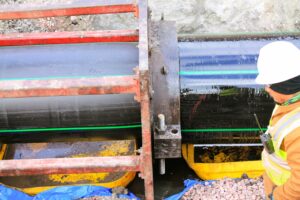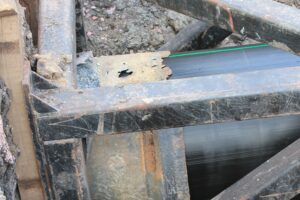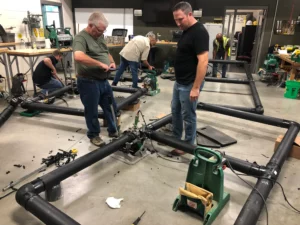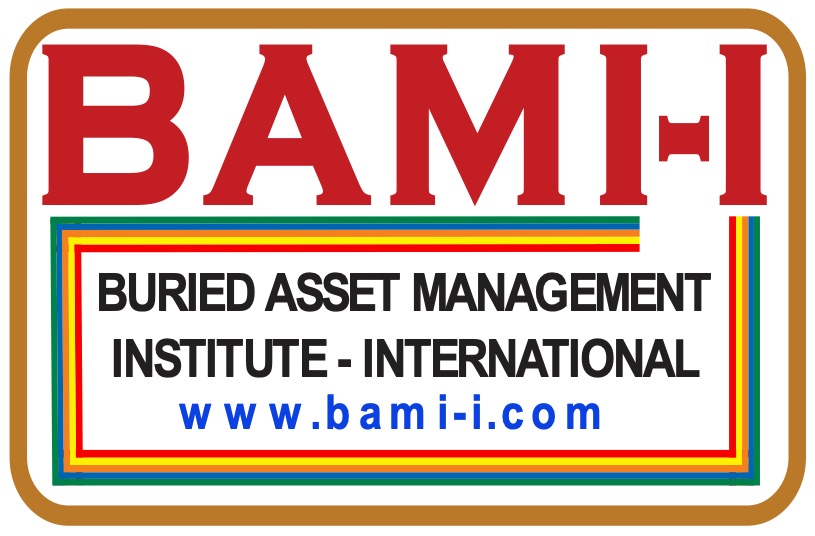SIOUX FALLS, S.D. – It wasn’t a typical, normal sliplining job to replace a failing force main line here. The original ductile iron pipe had deformed and had severe ovality. Hydrogen sulfide gas from the sewage flow made sulfuric acid, which collected at the top of the metal pipe and destroyed it. It was thought that pulling through a new pipe wouldn’t be possible as it would hang up on the deformed inner wall of the old pipe. Reducing the diameter was not possible — the diameter of the new pipe needed to be as close to the old one to maintain the rate of flow. The solution provided by Murphy Pipeline Contractors (Jacksonville, FL) was to use high-density polyethylene (HDPE) pipe and compress it to fit, knowing that the thermoplastic pipe would naturally reform itself.
“This is one of the inherent attributes of HDPE pipe,” stated Camille George Rubeiz, P.E., F. ASCE, co-chair, HDPE Municipal Advisory Board, and senior director of engineering for the Plastics Pipe Institute’s (PPI) Municipal & Industrial Division. “As well as being corrosion proof, it is flexible and ductile to go through a special die on the job site that makes it possible to be pulled inside a host pipe even when the pipe is not round. In this case, the ovality would have no affect during installation and the HDPE pipe would form a tight compression fit within the old ductile iron pipe.”
Established in 2008, the Municipal Advisory Board (MAB) serves as an independent, non-commercial adviser to the Municipal & Industrial Division of PPI, the major North American trade association representing the plastic pipe industry. MAB-conducted Fusion Seminars enable students to learn from experts and receive hands-on training in the proper fusion and electrofusion methods for HDPE water piping systems.
In Sioux Falls, more than 8,700 feet of 36-inch ductile iron sewer force main was replaced with HDPE PE 4710, DR 21 pipe using Murphy’s CompressionFit™ method, patent pending. The new pipe has a 100-psi operating and a 200-psi surge pressure rating, and is rated as a Class 6 solution in accordance with ASTM F3508. The sewer force main traversed under three city parks, along Covell Lake, through major commercial districts and under state highway SD 115. It was made and provided by WL Plastics (Fort Worth, TX), a member company of PPI.
Opened in 1985, the Sioux Falls system treats some 18 million gallons of wastewater daily. There are 900 miles of pipe in the system that conveys the wastewater to the city’s treatment plant. There is a $215 million expansion plan underway that will increase the facility’s capacity by 50 percent when completed in 2025.
“One of the questions we were asked was ‘Can a 36-inch ductile iron sewer force main with severe ovality be replaced with HDPE pipe using CompressionFit?’”, said HDPE pipe industry expert and consultant Harvey Svetlik, P.E. “The answer was an unequivocal ‘yes’. Matter of fact, some other recent projects saw 54-inch diameter pipe with a three-inch wall thickness installed using the CompressionFit method. One of the principal things that this technology does is that it preserves the flow rate of the existing host pipeline and seals over holes and leaks, so you have a dual-wall composite pipeline. And the thicker HDPE pipe provides structural integrity.”
Svetlik has more than 40 years of experience in the plastic pipe industry, specializing in polyethylene pipes and fittings. He is the inventor of the MJ Adapter, also known as the Harvey Adapter. An active member of PPI for 30 years, he is the author of numerous PPI technical notes, developer of ASTM/AWWA standards, and an inventor who holds 16 patents.
One of the most recent ASTM standards authored by Svetlik is ASTM F3508 for the installation of compressed fit shape memory polymer pipe. “ASTM F3508 codifies the specification of the material to use and deals with the shape memory characteristics of the material such as high-density polyethylene.
“With the CompressionFit technology, instead of elongating a rubber band and letting it recover as is done with Swagelining, they basically do a lot more of radial compression. Instead of stretching it and thinning the wall, they downsize it and radially thicken the wall, such that when it goes into place it enlarges in diameter, and the radial wall thickness stands as it expands out, like rolling out pie dough.”
The developer of CompressionFit is Murphy Pipeline Contractors (Jacksonville, FL). “Most cities cannot afford to relocate and replace a 16-inch diameter or larger pipeline within their vast utility network,” said Todd Grafenauer, education director for Murphy. “The result of the CompressionFit HDPE pipe lining technology is that a new HDPE pipe will be ‘compressive fit’ inside the existing host pipe. This lining offers remarkable value over other construction methods such as an increased flow rate over sliplining, we do an average pull distance of 2,000 feet with more than a 90 percent reduction in excavation and there’s no new easement documentation needed. Plus, we simply follow the existing pipe path using GIS maps.” Murphy is a member company of PPI and also part of the association’s Municipal Advisory Board (MAB).
Governed by ASTM F3508, the CompressionFit HDPE pipe lining technology specifies an HDPE pipe with an outside diameter larger in size than the inside of the host pipe to be renewed. After the HDPE is butt fused to correspond to the pull distance, the pipe is pulled through a reduction die immediately before entering the host pipe. This reduces the HDPE pipe temporarily below the inside diameter of the host pipe allowing it to be inserted.
While the towing load keeps the HDPE under tension during the pull, the pipe remains in its reduced size. The HDPE remains fully elastic throughout the reduction and installation process. After installation, the pulling load is removed. The HDPE pipe expands until it is halted by the inside diameter of the host pipe. The effectively natural ‘tight’ or ‘compression fit’ is accepted as exchanging an existing failing pipeline with a composite pipe in its place.
“One of the things about the ASTM F3508,” Svetlik explained, “is that it can be utilized not only for municipalities for gravity flow, but even more ideally for pressure pipes for water pipeline replacement, or force main replacement.”
More information can be found at www.plasticpipe.org/municipalindustrial or www.plasticpipe.org/mabpubs


The new 36-inch HDPE pipe replaces the corroded ductile iron pipe in the Sioux Falls, SD sewer system. Photo credit: Murphy Pipeline

Replacing the Sioux Falls corroded ductile iron pipe that had been eaten away by sulfuric acid caused by sewage, the HDPE pipe is inserted into the destroyed pipe using the CompressionFit method from Murphy Pipeline. Photo credit: Murphy Pipeline
Municipal Advisory Board Fusion Seminars
The MAB-NWTC Fusion Seminars include training on 4” DIPS high-density polyethylene (HDPE) water piping systems using both manual and hydraulic butt fusion procedures and electrofusion of couplers and saddles.
“This curriculum has been developed for HDPE utility employees such as Operators, Inspectors and Engineers with little to no prior experience in fusion,” explained Greg Scoby, P.E., Chairman of the Municipal Advisory Board (MAB) Utility Committee and previously the Engineering Manager for the City of Palo Alto, CA. “In 2020 and 2021, MAB surveyed utilities in the US and Canada and every utility selected this training as their number one priority. As such, MAB, which is utility led and utility run, prioritized its projects and made this training the number one priority to continuously improve the installation of HDPE fusion and electrofusion joints.”
The classes, both instructive and mostly hands-on, are taught by experts in the plastic pipe industry. Topics include standard electrofusion with couplers, standard electrofusion for saddles, manual butt fusion and instruction on using a hydraulic butt fusion machine. Attendees also learn about the MAB accepted standards and qualifications for water utility work.
“We heard many favorable comments from those who have attended our fusion classes,” stated Camille George Rubeiz, P.E., F. ASCE, co-chair, Municipal Advisory Board, and senior director of engineering, Municipal and Industrial Division of PPI. “These have included, ‘The destructive testing shows how good these fuses really hold up.’ ‘Very hands on and applicable to what needs to be done in the field.’ ‘The instructor is very knowledgeable and I did enjoy his class.’ ‘Sufficient hands-on training, real life demonstrations by instructors.’ ‘Enough equipment for everyone to participate.’ I liked the practice time.’ ‘If you have any questions, the instructor helped clear the doubt, and I enjoyed being able to see how strong the pipe is and how well the fusion joint held up.’ ”
The class size is limited to 10 students. The course is currently being conducted at the Northeast Wisconsin Technical College in Green Bay, which has the facilities and equipment available for the group’s use.
Upon successful completion of the required written, visual, and destructive testing, students receive a Certificate of Competency Completion Card from the college and a Qualification Card will be issued from the utility (owner) that has sponsored the trainee to attend the class.
To register or to find out more, scan:


About the Municipal Advisory Board:The mission of the Municipal Advisory Board (MAB) is to improve the design, installation, and operation of municipal HDPE water piping systems through the creation of partnerships among utilities, researchers, designers, contractors, and the HDPE industry. MAB serves as an independent, non-commercial adviser to the Municipal & Industrial Division of the Plastics Pipe Institute, Inc.
